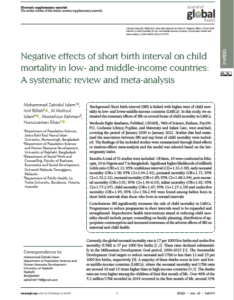
Methods
Eight databases, PubMed, CINAHL, Web of Science, Embase, PsycINFO, Cochrane Library, Popline, and Maternity and Infant Care, were searched, covering the period of January 2000 to January 2022. Studies that had examined the association between SBI and any form of child mortality were included. The findings of the included studies were summarized through fixed-effects or random-effects meta-analysis and the model was selected based on the heterogeneity index.
Results
A total of 51 studies were included. Of them, 19 were conducted in Ethiopia, 10 in Nigeria and 7 in Bangladesh. Significant higher likelihoods of stillbirth (odds ratio (OR) = 2.11; 95% confidence interval (CI) = 1.32-3.38), early neonatal mortality (OR = 1.58; 95% CI = 1.04-2.41), perinatal mortality (OR = 1.71; 95% CI = 1.32-2.21), neonatal mortality (OR = 1.85; 95% CI = 1.68-2.04), post-neonatal mortality (OR = 3.01; 95% CI = 1.43-6.33), infant mortality (OR = 1.92; 95% CI = 1.77-2.07), child mortality (OR = 1.67; 95% CI = 1.27-2.19) and under-five mortality (OR = 1.95; 95% CI = 1.56-2.44) were found among babies born in short birth intervals than those who born in normal intervals.
Conclusions
SBI significantly increases the risk of child mortality in LMICs. Programmes to reduce pregnancies in short intervals need to be expanded and strengthened. Reproductive health interventions aimed at reducing child mortality should include proper counselling on family planning, distribution of appropriate contraceptives and increased awareness of the adverse effects of SBI on maternal and child health.